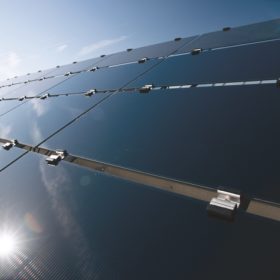PV installation costs to fall
Façades with integrated photovoltaics (PV) systems could be cheaper than traditional construction materials, according to the first Bodensee Symposium on Architecture and Solar Technology, which took place in Konstanz, Germany.
Hawaii: CPV terrestrial power investigation underway
A U.S. industry consortium is investigating the viability of concentrated photovoltaic (CPV) technology for terrestrial power generation in Hawaii, the U.S.
Panasonic Group pushes ahead with "full-scale" entry into solar cell business
The Panasonic Group has announced its plans to launch its HIT(R) 215 Series household solar power generation systems on July 1, thus highlighting the companys aim for a “full-scale entry” into the solar cell business.
Arizona could become alternative energy hotspot
More than 80 applications for solar and wind power plants have been submitted by developers in the state of Arizona, which are valued at tens of billions of dollars, reports The Arizona Republic.
US: Solar industry poised to create 200,000 jobs
200,000 domestic jobs and 10 gigawatts (GW) of new solar installations could be created in the U.S. if the Department of Treasury Grant Program (TGP) was extended by two years and solar manufacturing was included in the industries’ existing tax credit, says the Solar Energy Industries Association (SEIA).
Saudi Arabian solar task force established
A Saudi Arabian solar task force has been established following the countrys first Solar Communication and Coordination Workshop, held on May 16 in Saudi Arabia. Saudi Aramco, one of the worlds largest oil corporations, will assume a leading role.
New energy efficiency Compendium of Best US Practices published ??
Three leading energy efficiency and renewable energy organizations have jointly released a Compendium of Best Practices: Sharing Local and State Successes in Energy Efficiency and Renewable Energy from the United States.
Power grid could accommodate "large increase" in solar generation
Large increases in solar and wind generation could be accommodated in the power grid, according to a new study published by the National Renewable Energy Laboratory (NREL).
PV Legal launches new database highlighting "bureaucratic barriers" to PV development
The PV Legal consortium has launched an online database containing quantitative and qualitative data on project development processes and bureaucratic barriers that, they say, are hampering the set-up of photovoltaic (PV) systems.
Stanford team wins MIT Clean Energy Prize with new solar material
C3Nano, Inc., a company founded by Stanford University students, has won the 2010 MIT Clean Energy Prize for the development of a new transparent electrode material, which, it is claimed, will make photovoltaic solar panels both cheaper and more efficient.

